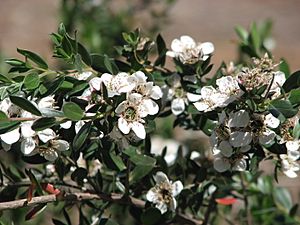Shiny tea-tree facts for kids
Quick facts for kids Shiny tea-tree |
|
|---|---|
 |
|
| Leptospermum nitidum in Maranoa Gardens | |
| Scientific classification | |
| Genus: |
Leptospermum
|
| Species: |
nitidum
|
| Synonyms | |
|
|
The Leptospermum nitidum, also known as the shiny tea-tree, is a type of compact shrub. It is a plant that is only found in Tasmania, an island state of Australia. This shrub has many leaves that are packed closely together. These leaves are oval-shaped and have a nice smell. The plant produces white flowers that are about 1.5 centimeters wide. Its fruits stay on the plant even after they are ripe. They only fall off if the plant burns or dies.
Contents
What Does the Shiny Tea-Tree Look Like?
The shiny tea-tree is a very bushy and compact shrub. It usually grows up to 2 meters (about 6.5 feet) tall. It has bark that looks like scales.
Leaves and Flowers
The leaves of the shiny tea-tree have a pleasant smell. They are mostly smooth and hairless. Each leaf is oval-shaped, about 8 to 20 millimeters long and 3 to 6 millimeters wide. They are shiny and often have a sharp point at the tip. The leaves narrow down at the base to a short stem called a petiole.
The flowers are white and about 1.5 centimeters (0.6 inches) wide. They grow at the ends of the leafy side branches. At the base of the flower buds, there are small, leaf-like parts called bracts and bracteoles. These are golden brown but usually fall off before the flower opens. The cup-shaped part of the flower, called the floral cup, is 4 to 6 millimeters long. It has triangular sepals, which are like small leaves that protect the bud, mostly 5 to 6 millimeters long. The petals are about 6 millimeters long, and the stamens, which hold the pollen, are 2.5 to 3 millimeters long.
Fruit and Flowering Time
Shiny tea-trees usually flower in January. After flowering, they produce a fruit called a capsule. This capsule is 6 to 10 millimeters long and has the sepals still attached. The fruit stays on the plant even after it is mature.
How Was the Shiny Tea-Tree Named?
The shiny tea-tree was first officially described in 1856. An English botanist named Joseph Dalton Hooker gave it its formal name, Leptospermum nitidum. He wrote about it in his book The Botany of the Antarctic voyage of H.M. Discovery ships Erebus and Terror. III. Flora Tasmaniae. He based his description on plants collected by Ronald Gunn. The second part of its name, nitidum, comes from a Latin word. It means "shining" or "bright," which fits the plant's glossy leaves.
Where Does the Shiny Tea-Tree Grow?
The shiny tea-tree likes cold and wet areas, especially in heathland. It is found all over Tasmania, including on Cape Barren Island.
Related Plants
- Leptospermum turbinatum, also called shiny tea-tree, is a different kind of spreading shrub. It is only found in the Grampians and nearby mountains in Victoria, Australia.
Images for kids
-
Leptospermum nitidum in Maranoa Gardens


